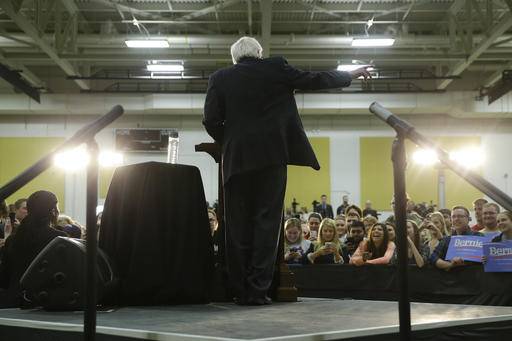As his fans keep telling us, it’s too early to count out Bernie Sanders. Even he admits that he’ll have to get an average of 65% of the pledged delegates from her on out, and of course, he’ll have to sway the “Superdelegates” who have already thrown in with Hillary Clinton. But, as they say, “a trip of a thousand miles starts with just one step,” and Bernie’s next step is Indiana.
International Business Times thinks Bernie has “A Future to Believe In.”
Lucky for Sanders, then, that Indiana will be the first place to hold a primary since the routs in Connecticut, Delaware, Maryland and Pennsylvania last week. If there’s any place where he can regain his footing, it’s the Hoosier State. A victory there Tuesday night wouldn’t make Sanders any more likely to win the nomination — but it could give him more clout at the convention, where he reportedly intends to fight for a more-progressive Democratic Party platform.
That’s because Indiana has some important features in common with Michigan, the site of the Democratic primary season’s most stunning upset. Michigan is where Sanders confounded the pollsters and recorded a decisive victory almost two months ago. His campaign staff has reason to hope for a similar performance in Indiana.
It all comes down to themes Sanders has sounded on the campaign trail and will likely want better represented in the Democratic platform: the shrinking of the middle class, the economic devastation wrought by free trade agreements and the decay of the American labor movement. Like Michigan, Indiana perfectly embodies these themes. The question is whether the resulting voter anger will deliver Sanders another much-needed victory.
Why Indiana?
For starters, Indiana is proportionally whiter than the U.S. as a whole: The Census Bureau estimated that 86 percent of Indiana residents were white in 2014, as opposed to 77 percent of Americans overall. While Sanders has made some inroads with the black community since he first launched his candidacy, he still tends to do best in states with largely white populations.
Bernie’s campaign manager thinks a win is quite possible.
“Well, we certainly could win. If people come out, we will certainly win in Indiana, absolutely. But, you know, it all depends on people coming out. People got to go to the polls,” Jeff Weaver told CNN. . .
Weaver also said Democratic National Committee Chairwoman Debbie Wasserman Schultz was “definitely wrong” for saying that only registered Democrats should choose the party’s nominee.
“It’s a recipe for a smaller party, a more insular party, a more establishment party, a party that’s more out of touch with the broader base of the American people, including the broad base of Democratically-leaning independents who as I said vote Democratic all the time,” Weaver said. “There’s a lot of young people who fall into this category, millions, who always vote Democratic but who have self-identified as independents but have a great affinity for the party. And to push those people away I think really endangers the long-term health of the Democratic Party.”
Bernie has put a lot into it.
All evidence points to a nailbiter in Tuesday’s only primary. Sanders has barnstormed the Indiana college campus circuit. Clinton has worked the state’s biggest cities, hoping to lock down the African-American vote.
She’s got strong support from the state’s top Democrats, but Sanders has an ace in the hole: Indiana’s open primary format means voters don’t have to be Democrats to participate in the Democratic primary. Open primaries are where Sanders shines: They helped grease his path to victory in Midwestern wins in Michigan and Wisconsin.
“It’s close,” said former Indiana Democratic Sen. Evan Bayh, a top Clinton surrogate.
The Sanders campaign has focused on labor and the youth vote. Five of the seven events Sanders has done in the state have been on college campuses. And the college towns Sanders has visited are treasure troves of young voters: Indiana University (about 36,000 undergraduates), Purdue University (29,000), Indiana University — Purdue University Fort Wayne (14,000), the University of Southern Indiana (8,400) and University of Notre Dame (8,400).
“The college towns argument is like the old adage. You ask Willie Sutton, ‘Why did you rob banks?’ and he said, ‘That’s where the money is,'” Pete D’Alessandro, the Sanders campaign Indiana state director, said. “You go where the votes are.”
Bernie has been gaining ground. The new Wall Street Journal/NBC News/Marist poll puts Hillary just four points ahead—a statistical dead heat, considering the margin of error.
Democratic presidential front-runner Hillary Clinton has a 4-point lead over rival Bernie Sanders days ahead of Indiana’s primary, within a new poll’s margin of error.
Clinton leads the Vermont senator among likely Democratic primary voters, 50 percent to 46 percent, in an NBC News/Wall Street Journal/Marist poll released Sunday morning.
The NBC/WSJ/Marist poll, conducted April 26–28, has a margin of error of 4.6 percentage points for Democrats.
It’s close. Bernie could actually take the state. It would depend on the support of workers, white people, college students, independents, and a good turnout. Unfortunately, “just winning” is not enough. Bernie needs to take 2/3 of the rest of the delegates. But a win of any kind would be a moral boost, and the campaign could sure use that, after the last few weeks.
Donate Now to Support Election Central
- Help defend independent journalism
- Directly support this website and our efforts
